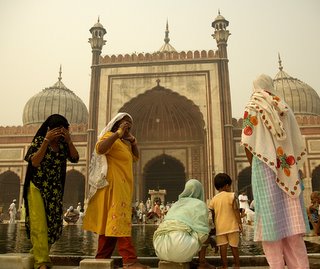Who cries when mothers die?
 here's my second article for India Together:
here's my second article for India Together:It's a little long, but the problem is no mean one either.
Who cries when mothers die?
The probability of an Indian mother dying during childbirth is roughly 10 times that of her Chinese counterpart. Reducing the Maternal Mortality Ratio (MMR) by three-quarters in 10 years is now a Millennium Development Goal. Why is MMR in India so high and how far are we from the goal? Arati Rao unravels the many challenges to saving mothers' lives.
21 November 2005 - Lhamu, a mother of twelve, lives in a remote village in Western Tibet. Three of her children died within a month of birth and the four year old strapped to her back looked as small as a one year old. She gave birth all alone, at home, all twelve times. But Lhamu was lucky. She didn't die. One in 33 women dies during childbirth in Tibet. Malnutrition, abject poverty and lack of any health care – however basic—plagues Lhamu's family, as it does much of Tibet. Tibet – vast lonely stretches of dead habit with nary a creature on its harsh plains and no economy to speak of. It can't be as bad here in new economy India, right?
Think again.
One in 48 women in India is at risk of dying during childbirth. The Maternal Mortality Ratio (MMR) in India is a high 407 per 100,000 live births, according to the National Health Policy 2002. Other sources put the MMR at a higher 540 (NHFS and UNICEF data, 2000). Reducing the Maternal Mortality Ratio (MMR) by three-quarters by 2015 is a Millennium Development Goal (MDG) for all countries including India. Achieving this means reducing the MMR to 100 by 2015. Part of the problem is this measurement – MMR data is just not there and if it is, it varies widely depending on what method was used to get it.
Studies show MMR among scheduled tribes (652) and scheduled castes (584) is higher than in women of other castes (516, according to one study). It is higher among illiterate women (574) than those having completed middle school (484). The key determinant seems to be access to healthcare. Less-developed villages had a significantly higher MMR (646) than moderately or well-developed villages (501 and 488 deaths, respectively).
"It is very sad that the numbers are so high even 57 years after independence," avers Dr H Sudarshan who is Vigilance Director (Health) of the anti-corruption body Karnataka Lokayukta. "Not only are the numbers from the Sample Registration System (SRS) high, they are also incomplete. We do not know how many mothers actually died during childbirth and why. Underreporting is rampant and people hide MMR numbers in fear of repercussions. We need state-wise and within states, district-wise data," says Sudarshan who was also Chairman of the Karnataka Health Task Force which made wide-ranging recommendations based on a 2-3 year detailed study conducted in the state. Regardless, the UN MMR numbers for India (540) are several times higher than those for other developing countries like China (56), Brazil (260), Thailand (44), Mexico (83) or even Sri Lanka (92).
Medical reasons
So what exactly leads to such a high MMR? ....
0 Comments:
Post a Comment
<< Home